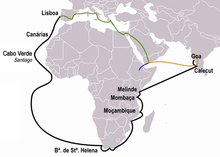Pêro da Covilhã
Pêro da Covilhã or Pedro da Covilhão (* 1450 in Covilhã , Beira ; † 1530 in Ethiopia ) was a Portuguese diplomat and researcher .
At a young age he went to Castile and entered the service of Don Juan de Gusman, brother of the Duke of Medina-Sidonia . When war broke out between Castile and Portugal some time later, he went back to Portugal. There he entered the service of Afonso V of Portugal as a noble page , who later elevated him to the knighthood (escudeiro). Even under Afonso's successor John II of Portugal , Pêro da Covilhã was in the service of the king.
Expedition to the east
John II made Covilhã responsible for various private missions. Since he could speak many different languages, he and Afonso de Paiva were given a mission to explore the Middle East and the surrounding regions of Asia and Africa, specifically to find out where cinnamon and other spices could be found. In addition, the land of the legendary Priest King John was to be found by land. At the same time, Bartolomeu Diaz was commissioned to find the land of the Priest-King by sea, to explore the end point of the African continent and the sea route to India .
The expedition started on May 7, 1487 near Santarém . Covilhã and Paiva were given credentials for all countries in the world and a map compiled from the world map by Bishop Calcadilha and Doctors Rodrigo and Moyses. The first two were the presiding members of the commission who advised the Portuguese government to reject Christopher Columbus ' requests . The researchers departed from Santarém and traveled from Barcelona to Naples . There her changes were taken over by the sons of Cosimo de 'Medici . They then traveled to Rhodes , where they stayed with two other Portuguese, and finally, pretending to be traders, traveled on to Alexandria and Cairo.
Accompanied by Arabs from Fez and Tlemcen , they walked along a rocky path to Sawakin and Aden . During the monsoon season , Covilhã and Paiva separated. Covilhã continued his journey to India, Paiva continued on to Ethiopia. They agreed to meet again in Cairo . Covilhã finally reached Kannur and Calicut , from where he planned his expeditions to Goa , Hormuz , the Red Sea and back to Cairo. On his way along the African east coast, he made a detour to Sofala . He was probably the first European who was there.
In Cairo he heard of Paiva's death and met two Portuguese Jews: Rabbi Abraham from Beja and Joseph, a shoemaker from Lamego , who had been sent by King John with letters for Covilhã and Paiva. Through Joseph, Covilhã responded with an account of his Indian and African travels and his observations of the cinnamon , pepper and clove trade at Kozhikode (Calicut). He added his advice on the sea route to India to the report. He presented this as feasible: the Portuguese could initially steer from their coast to Guinea . The first destination in the Eastern Ocean, he added, would be Sofala, or the Island of the Moon (now Madagascar ); The Kozhikode coast could be reached from any of these countries.
Ethiopia
With this information Joseph returned to Portugal, while Covilhã, with Abraham von Beja, again toured Aden and Hormuz. In Hormuz, he separated from the rabbi. He himself traveled to Jeddah , the gate of the Arab holy land, and (as he explained to Francisco Álvares many years later) even as far as Mecca and Medina . He reached Zeila via Mount Sinai and the Red Sea . From there he marched inland to the court of the "Priest King John" (Ethiopia).
There he was received with honor by Negus Eskandar ; Countries and dominions were given to him, but Eskander refused permission to leave the country again, as did his successor. In 1507 da Covilhã was visited by João Gomez, a priest who had been sent by Tristão da Cunha and who reached Ethiopia via Socotra .
When a Portuguese embassy with Francisco Alvares under Rodrigo De Lima reached Ethiopia in 1520, Covilhã wept with joy at the sight of his countrymen. It had been forty years since he had left Portugal and he had been a prisoner of Ethiopia for over thirty years.
Alvares, who declared that he knew him well and wanted to hear the story of his life, praised Covilhã's power of describing clearly so that one could directly imagine the things he was describing, as well as his extraordinary knowledge of all the spoken languages of Christians , Muslims and Gentiles . His services as a translator were very valuable to Rodrigo De Lima's followers. Covilhã was treated well but not allowed to leave the country alive.
literature
- Francisco Alvares : Chapter CIV: How Pero de Covilham, a Portuguese, is in the country of the Prester, and how came here, and why he was sent . The Prester John of the Indies. Hakluyt Society , Cambridge 1961, pp. 369-376.
Web links
- Biography on the side Vidas Lusofonas (English)
- The King's Scout - Pedro de Covilhao on the way to India Scinexx As of June 26, 2001
| personal data | |
|---|---|
| SURNAME | Covilhã, Pêro da |
| ALTERNATIVE NAMES | Covilhão, Pedro there |
| BRIEF DESCRIPTION | Portuguese diplomat and researcher |
| DATE OF BIRTH | 1450 |
| PLACE OF BIRTH | Covilhã , Beira , Portugal |
| DATE OF DEATH | 1530 |
| Place of death | Ethiopia |
